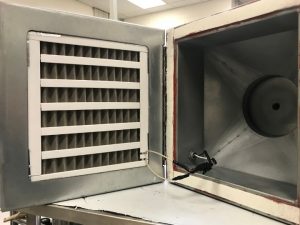
Air filter developed by University of Houston researchers kills 99.8% of coronavirus particles in a single pass
Researchers from the University of Houston (UH) collaborated with Medistar and others to develop an air filter that traps and kills airborne coronavirus and anthrax spore particles. The results of their research were published in Materials Today Physics July 7.
Zhifeng Ren, director of the Texas Center for Superconductivity at the University of Houston (TcSUH), was approached by Medistar March 31 to begin developing the filter.
“In order to stop particles you have to strike a balance of a porous material that air goes through, but with a high enough surface area to stop and kill harmful particles,” Ren said. “You also have to make sure the air going through the filter doesn’t heat too much.”
“We started to brainstorm and based on the research experience I have had, using materials we had in the lab, we considered the requirements of the filter, tested our design and it worked,” said Ren.
Postdoctoral researcher in physics Luo Yu’s experience at TcSUH using electrocatalysts like nickel foam to produce hydrogen from water allowed him the insight to test the relationship between conductivity and resistance in the development of the filter.
“Nickel Foam has low resistivity but is highly conductive. To use it as a filter, we asked ‘How do we make the foam have a high resistance?’ If resistance is too low, then current is too high and it is difficult to heat the filter,” Yu said. “We found that a folded structure obtains a high resistance. We tried many times and did many tests in the lab to design the final filter.”

Using folded Nickel foam and electrical wires, Ren and Yu were able to create a filter capable of trapping and killing the virus responsible for causing COVID-19. The filter heats to a temperature of around 200° C (392° F), killing virus particles as air passes through. A prototype was built by a local workshop and tested at TcSUH.
When tested at University of Texas Medical Branch’s Galveston National Laboratory for the filter’s ability to kill coronavirus, researchers found that it killed 99.8% of the novel Sars-CoV-2 virus and 99.9% of a tested anthrax spore in a single pass through the filter.
“This filter can catch and kill, stopping coronavirus with high efficiency. The deployment of these units will have a dramatic impact on essential workers,” said Yu. “The filter is useful for killing other airborne infectious agents, both known and unknown. It will help bring people’s lives back to normal.”
In a July 14 news release, CEO of Medistar Monzer Hourani and Physician Garrett Peel called for a phased rollout of the device “beginning with high-priority venues, where essential workers are at elevated risk of exposure (particularly schools, hospitals and health care facilities, as well as public transit environs such as airplanes).”
A phased rollout would improve safety for frontline workers in essential industries and allow nonessential workers to return to public workspaces, they said.
Faisal Cheema, associate professor of biomedical science at UH said in the release “this novel biodefense indoor air protection technology offers the first-in-line prevention against environmentally mediated transmission of airborne SARS-CoV-2 and will be on the forefront of technologies available to combat the current pandemic and any future airborne biothreats in indoor environments.”
“The pandemic significantly affects our whole society, almost every person in the world. How we get it under control is extremely important. As a scientist, we try to help,” said Ren. “In this particular case, I am glad I could use my experience to help. I feel very fortunate to have this opportunity and make a difference.”
